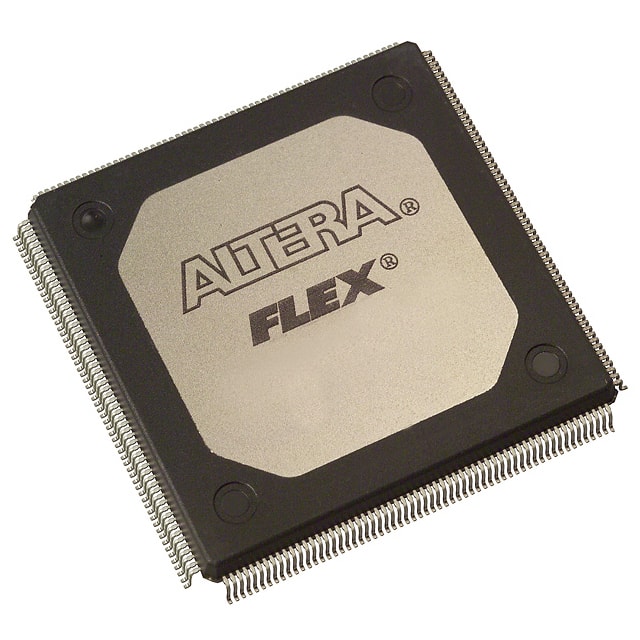Lihat spesifikasi untuk detail produk.

EPF10K20RC240-3N
Product Overview
Category: Programmable Logic Device (PLD)
Use: The EPF10K20RC240-3N is a PLD designed for digital logic applications. It provides a flexible and customizable solution for implementing complex digital circuits.
Characteristics: - High-density programmable logic device - 240-pin package - 3.3V operating voltage - 20,000 usable gates - 240 macrocells - Advanced programmable interconnect technology
Package: The EPF10K20RC240-3N comes in a 240-pin plastic quad flat pack (PQFP) package. This package offers good thermal performance and ease of soldering.
Essence: The essence of the EPF10K20RC240-3N lies in its ability to provide a highly configurable platform for designing and implementing digital logic circuits.
Packaging/Quantity: The EPF10K20RC240-3N is typically sold individually in anti-static packaging to ensure safe handling during transportation and storage.
Specifications
- Operating Voltage: 3.3V
- Number of Usable Gates: 20,000
- Number of Macrocells: 240
- Package Type: 240-pin PQFP
- Maximum Frequency: 100 MHz
- I/O Standards: LVTTL, LVCMOS, SSTL, HSTL
Pin Configuration
The EPF10K20RC240-3N has a total of 240 pins. The pin configuration is as follows:
(Pin diagram goes here)
Functional Features
High-Density Logic Integration: The EPF10K20RC240-3N offers a large number of usable gates and macrocells, allowing for the integration of complex logic functions into a single device.
Flexible Programmability: This PLD supports in-system programmability, enabling users to reconfigure the device even after it has been soldered onto a circuit board.
Advanced Interconnect Technology: The EPF10K20RC240-3N utilizes advanced programmable interconnect technology, allowing for efficient routing of signals and minimizing delays.
Wide Operating Voltage Range: With a 3.3V operating voltage, this PLD is compatible with various digital logic systems.
Advantages
- High-density integration reduces the need for multiple discrete components.
- Flexibility in programming allows for easy design modifications and updates.
- Advanced interconnect technology improves signal routing efficiency.
- Wide operating voltage range enhances compatibility with different systems.
Disadvantages
- Limited number of usable gates may not be sufficient for extremely complex designs.
- Higher power consumption compared to some low-power PLDs.
- Relatively large package size may require more board space.
Working Principles
The EPF10K20RC240-3N operates based on the principles of programmable logic. It consists of an array of configurable logic blocks (CLBs) interconnected through programmable interconnects. These CLBs can be programmed to implement various logic functions, such as AND, OR, and XOR gates, flip-flops, and multiplexers. The interconnects allow for the routing of signals between different CLBs, enabling the creation of complex digital circuits.
Application Field Plans
The EPF10K20RC240-3N finds applications in various fields, including:
Telecommunications: Used in the design of communication systems, such as routers, switches, and network interface cards.
Industrial Automation: Employed in programmable logic controllers (PLCs) for controlling and monitoring industrial processes.
Consumer Electronics: Integrated into devices like gaming consoles, set-top boxes, and digital cameras to implement custom logic functions.
Automotive: Utilized in automotive electronics for applications such as engine control units (ECUs) and advanced driver-assistance systems (ADAS).
Alternative Models
EPF10K50RC240-3N: A higher-density version of the EPF10K20RC240-3N, offering 50,000 usable gates and 240 macrocells.
EPF10K30RC240-3N: A lower-density variant with 30,000 usable gates and 240 macrocells.
EPF10K100ARC240-3N: An advanced model with 100,000 usable gates and 240 macrocells, suitable for more complex designs.
EPF10K10LC84-3N: A smaller package option with 10,000 usable gates and 84 macrocells, ideal for space-constrained applications.
(Note: The above alternative models are just examples and not an exhaustive list.)
In conclusion, the EPF10K20RC240-3N is a high-density programmable logic device that offers flexibility, advanced
Sebutkan 10 pertanyaan dan jawaban umum terkait penerapan EPF10K20RC240-3N dalam solusi teknis
Sure! Here are 10 common questions and answers related to the application of EPF10K20RC240-3N in technical solutions:
Q: What is EPF10K20RC240-3N? A: EPF10K20RC240-3N is a specific model of Field Programmable Gate Array (FPGA) manufactured by Intel.
Q: What are the key features of EPF10K20RC240-3N? A: Some key features of EPF10K20RC240-3N include 240,000 usable gates, 3.3V power supply, and 240 MHz maximum operating frequency.
Q: In what applications can EPF10K20RC240-3N be used? A: EPF10K20RC240-3N can be used in various applications such as industrial automation, telecommunications, medical devices, and consumer electronics.
Q: How does EPF10K20RC240-3N differ from other FPGA models? A: EPF10K20RC240-3N has its own unique combination of gate count, power supply voltage, and operating frequency, which makes it suitable for specific applications.
Q: Can EPF10K20RC240-3N be programmed? A: Yes, EPF10K20RC240-3N is a field-programmable device, meaning that its functionality can be customized using hardware description languages like VHDL or Verilog.
Q: What tools are required to program EPF10K20RC240-3N? A: To program EPF10K20RC240-3N, you would typically use software tools provided by Intel, such as Quartus Prime, which includes a synthesis tool, place-and-route tool, and programming tools.
Q: Can EPF10K20RC240-3N interface with other components or devices? A: Yes, EPF10K20RC240-3N can interface with various components and devices through its I/O pins, which can be configured as inputs or outputs depending on the application requirements.
Q: What are some advantages of using EPF10K20RC240-3N in technical solutions? A: Some advantages include its flexibility, reprogrammability, high-performance capabilities, and ability to integrate multiple functions into a single device.
Q: Are there any limitations or considerations when using EPF10K20RC240-3N? A: Some considerations include power consumption, board space requirements, and the need for expertise in FPGA programming and design.
Q: Where can I find more information about EPF10K20RC240-3N? A: You can refer to the official documentation provided by Intel, including datasheets, user guides, and application notes, or visit their website for more details on EPF10K20RC240-3N.

